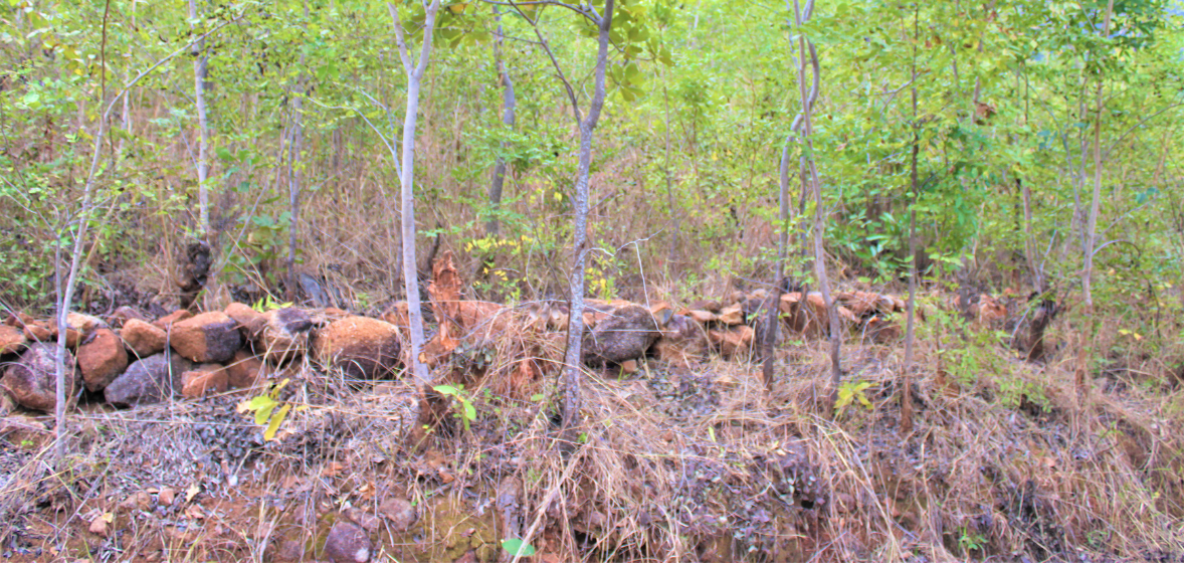 Trees regenerating in the Chikala hills, Machinga district, Malawi. (Credit: Felix Malamula, ERASP/PRIDE)
Trees regenerating in the Chikala hills, Machinga district, Malawi. (Credit: Felix Malamula, ERASP/PRIDE) The RFS Malawi project is engaging communities in integrated catchment management activities to reduce erosion, regenerate forest cover and build community resilience.
Story and images by Felix Malamula (ERASP/PRIDE)
For many years, communities in Senior Chief Chamba’s area in Machinga district, South-Eastern Malawi, have been grappling with intense flooding during the rainy season.
Streams and gullies, originating from the nearby Chikala hills, have been directing heavy running waters down into the villages, destroying crops and houses in the process. The devastation, which is now a yearly mainstay, perpetually leaves communities houseless and in need of food.
“It actually became traditional but also painful,” said Pempho Nachipo, a resident of the area. “Our crops were never spared. We grew crops knowing pretty well that at a certain point during the growing season, part of the fields would be washed away.”
Under natural conditions, the rain water would translate into an improved water table for the area, and serve a benefit to farmers and communities. However, a long history of deforestation, land degradation and unsustainable farming practices in the area made the land impermeable. This also affected access to drinking water as community boreholes would dry up just a few months into the dry season.
“It used to be a challenge but we thank ERASP because this is now history,” says Madalitso Makisoni, a woman living in the area.
The Resilient Food Systems (RFS) Malawi project, Enhancing the Resilience of Agro-Ecological System Project (ERASP) is project being implemented by the International Fund for Agricultural Development and the Malawi Ministry of Agriculture through its Programme for Rural Irrigation Development (PRIDE). The project uses an integrated landscape planning process to hydrological sub-catchments and an agro-ecological approach to improving food security, and it is working to raise agricultural yields on rain-fed farming systems through climate-smart and conservation agricultural methods.
In Malawi, ERASP is being implemented in the four districts of Dowa, Karonga, Machinga and Phalombe.
Through ERASP, communities have been empowered with knowledge on the conservation of their surrounding environments, and are applying new techniques like construction of check dams, stone bunds, gabion baskets, water absorption pits and other structures.
With the land and water conservation structures communities have put in place, coupled with new forest cover that communities are achieving through forest regeneration and tree-planting, the catchment areas are now well protected.
“Additionally, the catchment management activities under ERASP interventions have ensured that the water flowing down the hill into our fields is slowed thereby causing no havoc as it used to,” explained Pempho Nachipo.
Over the past three years, the heavy flooding that destroyed crops is no longer present. Protection of the crops means farmers are now enjoying bumper harvests. Minimal or zero disturbances to their residential areas means the farmers lives are also stable, enabling them to concentrate on improving their farming and other economic activities.
Constructing the structures that are now effectively controlling the flow of water downstream into the fields and residential areas has been laborious, to say the least. Community members traversed long distances and hilly areas carrying big stones to build the stone bunds. But as one member explains, their motivation comes from the evidence of what the activities are contributing toward community resilience.
“This is our area. The benefits accrued are being enjoyed by ourselves. So, there is no point in expecting any material or monetary benefits,” explains Makaika Sumani, a member of a committee managing the environment in the area. For the community, investing in themselves is time and energy well spent.
The hills are even regenerating with trees, as cut tree stumps have been left to regrow; the nearby Chikala hill that was once bare is quickly turning green.
Where the forests used to be a source of charcoal and a target for overexploitation, communities are now hanging beehives in them to symbiotically contribute to their flourishing and turn local production toward the more lucrative practice of honey production, supported by ERASP.
Honey production is an incentive on its own persuading community members to not only plant more trees, but also ensure that those already planted grow and contribute to achieving the forest cover the hill is currently enjoying.
Subscribe to our monthly newsletter to receive updates on stories directly from the field across all our projects, upcoming events, new resources, and more.